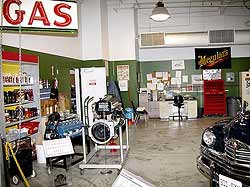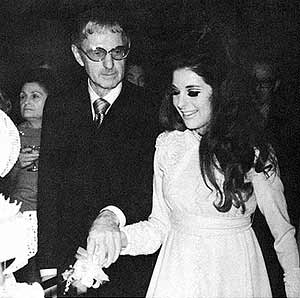
Vehicles are repaired
and serviced on site, in full view of museum
visitors. Some are loaned out for special
events, requiring them to be kept in perfect
running condition. (Photo by Dave Wallace/Good
Communications) |

“Nearly 1500 cars was too large a collection
for anyone, even Bill Harrah, to look after
and display,” in the opinion of historian
Foster. “I am told that many of them were
simply warehoused or even left out in the (admittedly-fairly-benign)
Nevada elements. Thus, the auction sell-off
actually put many of these cars back into circulation,
in the hands of people who would love them individually
and, hopefully, restore them or at least use
them.”
In his definitive Harrah biography, “William
Fisk Harrah: The Life And Times Of A Gambling
Magnate”, Doubleday, author Leon Mandel
revealed that Harrah’s seventh and last
wife, Verna, had urged her husband to add a
provision to his will preventing whoever acquired
his company from selling the collection:
“’I’d never do that,’ he
answered. ‘That’s my thing, not theirs.
They should be able to do whatever they want.’”

The fourth (of seven!)
Mrs. Harrahs was singer-songwriter Bobbie
Gentry, whose sole country-crossover hit,
“Ode To Billy Joe”, is still heard
on the radio. The marriage didn’t last
as long: Only four months after this 1969
cake-cutting ceremony, the odd couple separated.
|
“Verna was incredulous. ‘You’d
sell those cars?’”
“’Yeah, but I’d probably start
all over.’”
The late Mandel, a longtime Reno resident and
the universally-respected editor of Autoweek,
was among the journalists and civic leaders
who led the charge to (A) persuade Holiday Corporation
to donate some of the most-important vehicles
to a permanent museum and (B) solicit donations
of sufficient money and real estate to erect
and maintain a new home for the survivors. A
nonprofit organization was formed and, eventually,
raised approximately $10 million. Finally, in
1989, the National Automobile Museum opened
across the street from Harrah’s Hotel.
The single-level building boasts 105,000 square
feet of display space and more than 200 cars,
trucks and motorcycles representing the entire
existence of the automobile, including significant
race cars. Two survivors from the original collection
are Don Prudhomme’s world-beating 1975
Monza and Don Garlits’ late-1974-model
fueler, which was seen mostly at AHRA Grand
American Series events, and helped clinch the
AHRA points championship.
ADVERTISEMENT
 |
“It was not a good car,” e-mails
Garlits about one of his few surviving dragsters
not spending its retirement in Ocala, Fla. “I
only ran it several times before Bill Harrah
called and wanted to buy it. I sold him Swamp
Rat 20 over the phone, after a visit to his
museum during 1974. He wanted a Garlits car
and agreed to take one that did not run. He
generally wanted all his exhibits to run as
they did when they were in service. He sent
a truck to Seffner and picked up the car as
a static display. The price was $7,500. He didn’t
lose on that deal!”

|